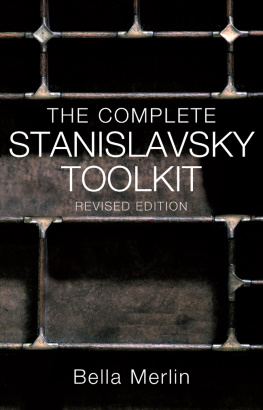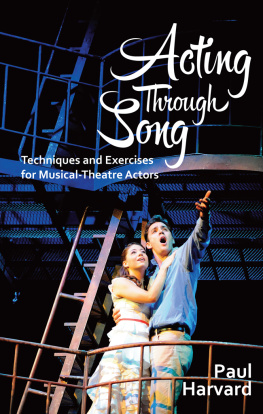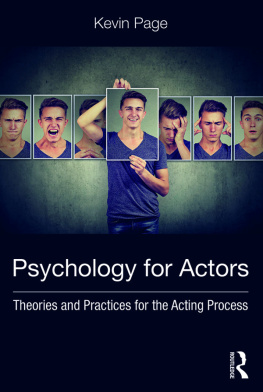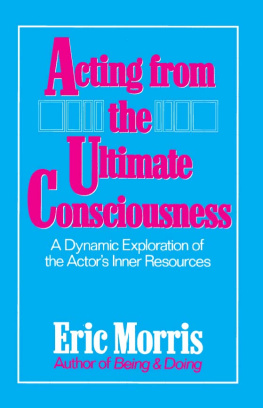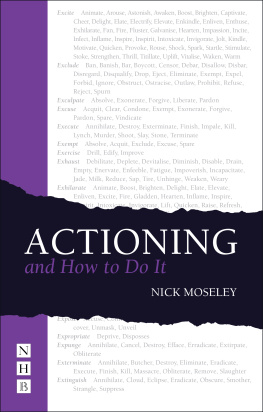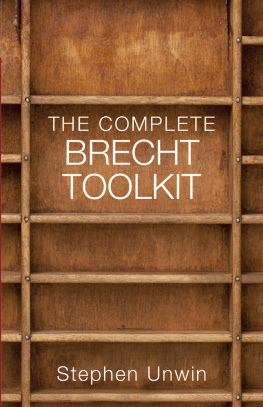The Complete
Stanislavsky Toolkit
BELLA MERLIN

NICK HERN BOOKS
London
www.nickhernbooks.co.uk
Contents
For Margaret, Michael and Miles
Preface to New Edition
2013 marked one hundred and fifty years since Konstantin Stanislavsky was born. Across the theatre world, there were celebrations and salutations for the man who catapulted acting from stereotypes to subtleties, from imitation to embodiment, and from stock theatricality to the inner life that resonates on stage and screen today.
This book The Complete Stanislavsky Toolkit was first published in 2007 by Nick Hern Books. Nick had also published my first book, Beyond Stanislavsky, and in subsequent conversations Id frequently talked about tools and toolkit terms that Id coined from my Russian Scenic Movement director, Vladimir Ananyev. I didnt really like system or method to describe Stanislavskys work, and I was excited when Nick gave me the charge to write a toolkit, a book that made readily accessible an array of Stanislavskys acting strategies. Little did we realise, as we sat in our favourite Italian haunt near Shepherds Bush Underground, what an egg we were hatching and my gratitude to Nick is immense.
One of my main resources for The Toolkit was Elizabeth Reynolds Hapgoods 1936 translation of An Actor Prepares. Although this is a seminal text for actors and directors across the English-speaking world, its actually a highly abridged version of Stanislavskys original tome. So I was very intrigued when, in 2008, Jean Benedettis translation of the full version, An Actors Work, appeared in print. Here, Benedetti introduced new translations of the Hapgood terms, and these translations were closer to the Russian originals and oftenmore actor-friendly. Although The Complete Stanislavsky Toolkit had already been on the market for a year, Benedettis changes set me thinking about the ways in which actors and directors use terminology. What works for an actor? What alienates an actor? Which word is best objective, task, desire or need? Is unit a useful name for a chunk of text, or is bit more appropriate (especially as its closer to the original Russian word, kusok)? Does it even matter what terms you use as long as you get the results?
In April 2012, I was invited to give the Annual Stanislavski Centre/Routledge Lecture at the Stanislavski Centre, UK, so I set some gentle cats among some gentle pigeons by posing these questions. I began to wonder if there was a gap between theatre scholars (who advocate absolute fidelity to Stanislavskys originals) and practitioners like myself (who aspire to acting excellence whatever the specifics of terminology). Given this fascination with acting vocab, I was delighted when Nick Hern agreed to publish a revised edition of The Toolkit. Here was an opportunity to update the first edition, in light of both Benedettis 2008 translation and my own experimentations as an actor and a trainer.
The main terms that Ive adopted from Benedettis An Actors Work are: inner psychological drives (rather than Hapgoods inner motive forces) and logic and sequence (rather than logic and coherence). The reason Ive chosen inner psychological drives is essentially instinctive. As an actor, I find the focus on drives more helpful than forces: What is driving my character to do this? yields me more imaginative fruit than What is forcing my character to do this? Although personally Id rather they were called psycho-physical drives, psychological is arguably a more accessible adjective than motive in this particular context.
My choice for logic and sequence over logic and coherence is quite simple. Ive found that the more we understand as actors the ways in which one action leads to the next action, to the next, to the next, to the next in a logicalsequence the more precise our process becomes. (I learned this very much from working with my own acting coach, Katya Kamotskaya, when she directed me in The Seagull in 2010.) I write in The Toolkit about the Action-Reaction-Decision sequence that underpins all human discourse. If you can genuinely open yourself up to all the nuances of this sequence and if you listen to your onstage partner, something really dynamic can happen between you. You no longer have to fake it and force it: instead, you can feel the electric way in which youre dependent on each others actions, reactions and decisions. And this process can occur regardless of genre or style be it vampires and wolves, or doctors and nurses. Each character in each context will have a particular logic underpinning their choices, and that logic moves them sequentially from one action to the next to the next.
The main (somewhat radical) adaptation that Ive made concerns communication, which is the title of Chapter 10 in An Actors Work. This is Jean Benedettis translation of Elizabeth Hapgoods communion. For many years I used the term communion, fully aware that it had an esoteric, almost religious overtone. Yet I enjoyed the unseen qualities implicit in the idea of communing with something be it God or Man or Nature. After all, Stanislavsky was very intrigued by yoga and prana energy, and certainly the word communion implies some silent connection, in which the tiny nuances of energetic changes, facial expressions and body positions give as much information as any spoken word. That said, I cant deny that on a couple of occasions Ive had workshop participants show a little resistance to the term communion. So I was more than happy to look for an alternative. However, Benedettis communication didnt work for me either. In our technological age, the word communication comes with a heap of digital and electronic overtones, and seems to reduce the intangible, intuitive aspects of human intercourse. Since neither term seems to be entirely serviceable, Ive adapted them in my own practice to the word connection, sinceconnection allows for both physical and energetic contact. And thats the term that Ive used here in The Toolkit.
There are a handful of terms that Ive left in The Toolkit, although I dont really use them any more: they include mental reconnaissance and concentration of attention. Mental reconnaissance no longer resonates for me. As an actor-trainer, I tend to avoid any direct reference to mental processes or anything that separates the actors thinking mind from their imaginative body. Since writing The Complete Stanislavsky Toolkit, Ive come to understand much more fully the term bodymind (a concept that I didnt wholly embrace five years ago: see pp. 2556). The whole idea of psycho-physicality means that its almost impossible to separate your brain from your body. And neuroscience categorically endorses that fact. So I now refer to detailed text analysis or mental reconnaissance as forensic detective work. To me, that sounds less cerebral and more imaginative. As someone hooked on the television documentary Forensic Files and real-life crime, it feeds my imagination to think about scraping away at the skeleton of the black-and-white text to trace back to the flesh-and-blood character. Text analysis sounds a bit dull. Mental reconnaissance sounds like a general poring over battle plans. Forensic detective work brings with it the excitement of uncovering something that may never have been discovered before. Therefore, it gives space for the actors imagination and unique interpretation. So, although Ive kept mental reconnaissance in this book, I frequently use an alternative.
One of the nitty-gritty terms with which Benedetti and his Russian-language consultant, Katya Kamotskaya, wrestled in

